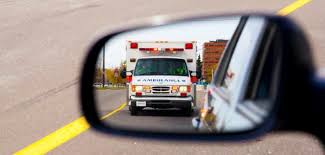 Throughout out time driving, emergency vehicles will pass us so they can tend to an accident or a vehicle with car problems. Unfortunately, many people forget what the proper thing to do is when an emergency car passes us as we are driving. In Texas, the law says that when this situation arises the driver is supposed to pull-over to the right-hand side of the road and stop. This law is easy to follow if the emergency vehicle is traveling the same direction as the driver. However, drivers become confused on what the proper course of action is when the emergency vehicle travels in the opposite direction. To clear up the confusion, regardless of which way the emergency vehicle is traveling, the driver should still pull-over to the right-hand side of the road and stop. The Transportation Code specifically addresses this in a statute described below.
Throughout out time driving, emergency vehicles will pass us so they can tend to an accident or a vehicle with car problems. Unfortunately, many people forget what the proper thing to do is when an emergency car passes us as we are driving. In Texas, the law says that when this situation arises the driver is supposed to pull-over to the right-hand side of the road and stop. This law is easy to follow if the emergency vehicle is traveling the same direction as the driver. However, drivers become confused on what the proper course of action is when the emergency vehicle travels in the opposite direction. To clear up the confusion, regardless of which way the emergency vehicle is traveling, the driver should still pull-over to the right-hand side of the road and stop. The Transportation Code specifically addresses this in a statute described below.
§545.156 – VEHICLE APPROACHED BY AUTHORIZED EMERGENCY VEHICLE
(a) On the immediate approach of an authorized emergency vehicle using audible and visual signals…, or of a police vehicle lawfully using only an audible signal, an operator, unless otherwise directed by a police officer, shall:
(1) yield the right-of-way;
(2) immediately drive to a position parallel to and as close as possible to the right-hand edge or curb of the roadway clear of any intersection; and
(3) stop and remain standing until the authorized emergency vehicle has passed.
(b) This section does not exempt the operator of an authorized emergency vehicle from the duty to drive with due regard for the safety of all persons using the highway.
Another situation that involves emergency vehicles is when the emergency vehicle is stopped on the side of the road as we are passing the scene of incident. As individuals approach this scenario, the driver mainly has two options to chose from. The driver can move to the farthest lane from the emergency vehicle. Depending how narrow the roads are or if there is construction that prevents one from doing that, the driver may not be able to utilize that option. If that is the case, then the driver must drive 20 miles per hour below the posted speed limit. The policy reasoning for both options is to give the emergency roadside assistance space to help the other drivers and it provides a safe environment for them to do their job. The Transportation Code explains this situation in the statute below.
§545.157 – PASSING CERTAIN VEHICLES
(b) On approaching a vehicle described by Subsection (a), an operator, unless otherwise directed by a police officer, shall:
(1) vacate the lane closest to the emergency vehicle when driving on a highway with two or more lanes traveling in the direction of the emergency vehicle; or
(2) slow to a speed not to exceed:
(A) 20 miles per hour less than the posted speed limit when the posted speed limit is 25 miles per hour or more; or
(B) five miles per hour when the posted speed limit is less than 25 miles per hour.
If you have experienced a car accident, it is crucial to contact a skilled attorney like Eric Reyes to represent you. Eric Reyes has been a practicing attorney in the area of personal injury for 30 years. His litigation team has been with him for 20+ years, so he and his team work well and efficiently to get a result for the case. Throughout his time focusing on personal injury law, he has met the requirements to be a Board Certified Attorney in Personal Injury Trial Law and Civil Law. His knowledge of personal injury can help you determine the best way to resolve your matter. Please give our office a call at (817) 332-1522 for further information.
 Fort Worth Injury Attorney Blog
Fort Worth Injury Attorney Blog

